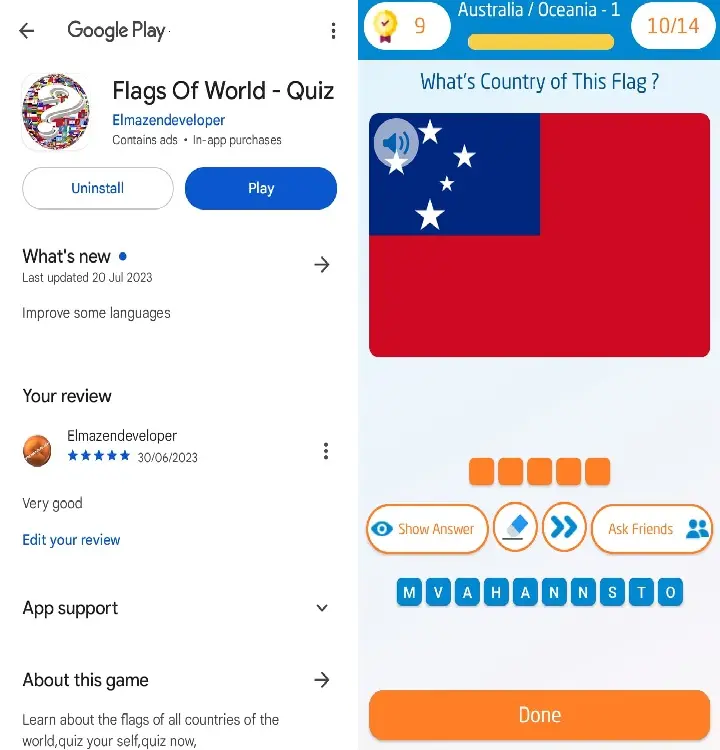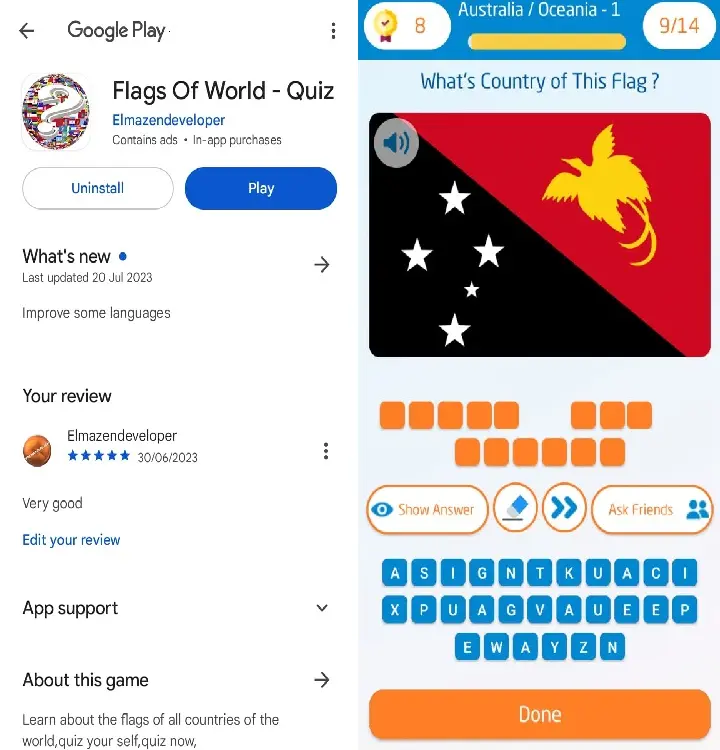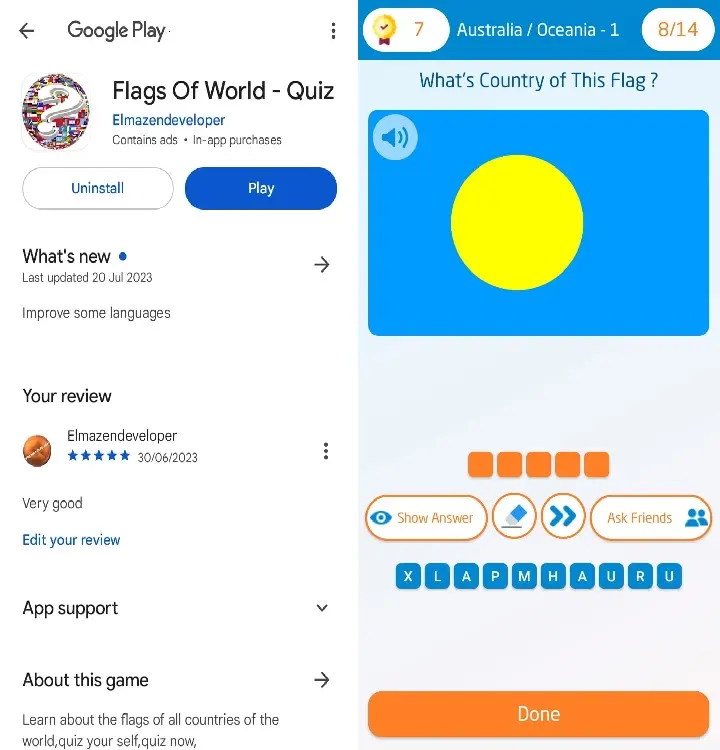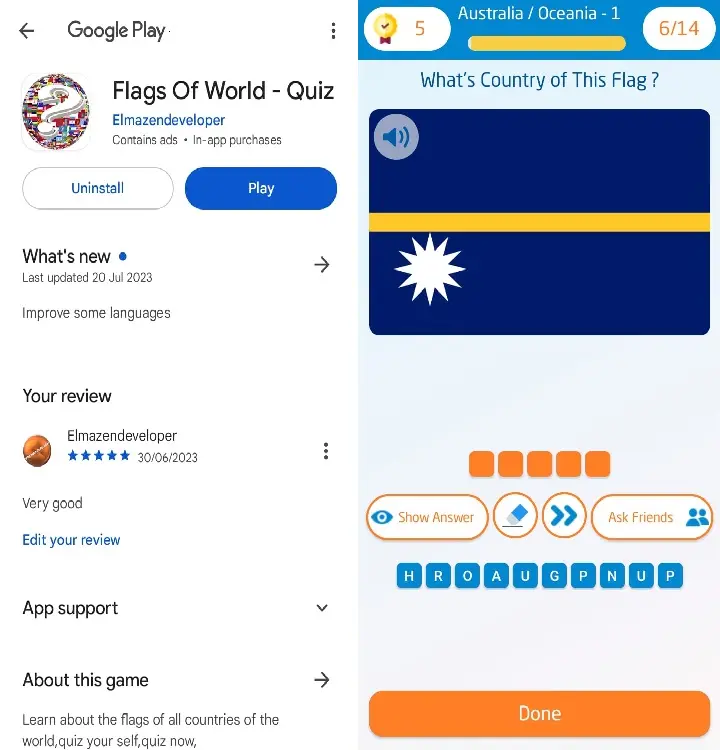- Details
- Written by: Elmazen
- Category: Flags of Countries of the World
- Hits: 729
Flag of Samoa
Flag of Samoa, Currency, Population, Tourist Places, Borders, Culture
Discovering Samoa: A Land of Beauty and Culture
Samoa, often called the "Treasured Islands of the South Pacific," is a breathtaking country rich in culture, natural beauty, and history.
Located in the heart of the Pacific Ocean, this island nation offers much to explore.
Here’s a closer look at some key aspects of Samoa:
Flag of Samoa

Download the application  Flags Of World - Quiz ,
Flags Of World - Quiz ,
And test your knowledge with Flags of World ,
1. Population of Samoa
Samoa has a population of approximately 218,500 people as of November 2024.
The majority of Samoans live on the two main islands, Upolu and Savai’i, with the capital city, Apia, located on Upolu.
Samoans are known for their strong sense of community and traditional lifestyle.
2. Meaning of the Samoa Flag
The national flag of Samoa features a red field with a blue rectangle in the upper left corner containing five white stars.
These stars represent the Southern Cross constellation, symbolizing Samoa's location in the southern hemisphere.
- Red: Stands for courage.
- Blue: Represents freedom.
- White: Symbolizes purity and honesty.
3. Samoa’s Currency
Samoa's official currency is the Samoan Tala (WST).
One tala is subdivided into 100 sene (cents).
The currency reflects the country’s cultural heritage, with images of traditional artifacts and landmarks on coins and banknotes.
Flag of Samoa

Download the application  Flags Of World - Quiz ,
Flags Of World - Quiz ,
And test your knowledge with Flags of World ,
4. Borders of Samoa
Samoa is an island nation and does not share land borders with any country.
It is surrounded by the Pacific Ocean.
However, its closest neighbors include:
- American Samoa (a U.S. territory to the east)
- Tonga (to the south)
- Fiji and Wallis and Futuna (to the west)
5. Culture of Samoa
Samoa is deeply rooted in its traditional culture, known as the Fa’a Samoa or "The Samoan Way".
This encompasses respect for elders, strong family bonds, and communal living.
Key Cultural Highlights:
- Tattooing: Tattoos, or tatau, hold great cultural significance, symbolizing identity and heritage.
- Dance and Music: Traditional Samoan dances, like the Siva, are often performed during celebrations, accompanied by drumming and singing.
- Food: Samoan cuisine features local staples like taro, breadfruit, and seafood.
The umu, an earth oven, is a traditional method of cooking.
- Language: The official languages are Samoan and English.
6. Best Places to Visit in Samoa
Samoa is a tropical paradise with many attractions, from pristine beaches to cultural landmarks.
Here are some must-visit places:
- To-Sua Ocean Trench: A stunning natural swimming hole surrounded by lush greenery.
- Lalomanu Beach: Famous for its white sand and turquoise waters.
- Savai’i Island: Known for its volcanic landscapes, waterfalls, and traditional villages.
- Robert Louis Stevenson Museum: A historic residence dedicated to the famous author who spent his last years in Samoa.
- Alofaaga Blowholes: Spectacular natural geysers on the coast of Savai’i.
- Papapapaitai Falls: One of the highest waterfalls in Samoa, located in Upolu.
Conclusion
Samoa is a country of vibrant traditions, breathtaking scenery, and warm hospitality.
Whether you're interested in exploring its cultural heritage or relaxing by the beach, Samoa offers something for every traveler.
Flag of Samoa

Download the application  Flags Of World - Quiz ,
Flags Of World - Quiz ,
And test your knowledge with Flags of World ,
- Details
- Written by: Elmazen
- Category: Flags of Countries of the World
- Hits: 763
Flag of Papua New Guinea
Flag of Papua New Guinea, Currency, Population, Borders, Culture, Tourist Places
Discover Papua New Guinea: A Land of Rich Culture and Natural Beauty
Papua New Guinea (PNG) is a captivating country located in the Pacific Ocean, known for its incredible diversity in culture, landscapes, and wildlife.
Let’s explore some fascinating aspects of this unique nation.
Flag of Papua New Guinea

Download the application  Flags Of World - Quiz ,
Flags Of World - Quiz ,
And test your knowledge with Flags of World ,
1. Population of Papua New Guinea
As of November 2024, Papua New Guinea has an estimated population of approximately 10.6 million people.
The population is distributed across its vast islands and mountainous terrain, with a majority living in rural areas.
PNG is one of the most culturally diverse nations, boasting over 800 distinct languages and numerous ethnic groups.
2. Papua New Guinea’s Flag Meaning
The flag of Papua New Guinea was officially adopted on July 1, 1971.
It is a striking design with significant symbolism:
- Black and red background: These are traditional colors in Papua New Guinean art and culture.
- Southern Cross constellation (white stars): Represents the country's location in the Southern Hemisphere and its connection to neighboring countries in the Pacific.
- Raggiana bird-of-paradise (gold): Symbolizes freedom and Papua New Guinea's rich natural heritage, as this bird is a national emblem.
3. Papua New Guinea’s Currency
The official currency of Papua New Guinea is the Papua New Guinean Kina (PGK), introduced in 1975 following the country’s independence.
The Kina is further divided into 100 toea.
The word "kina" is derived from a traditional shell currency used in the region.
Flag of Papua New Guinea

Download the application  Flags Of World - Quiz ,
Flags Of World - Quiz ,
And test your knowledge with Flags of World ,
4. Borders of Papua New Guinea
Papua New Guinea occupies the eastern half of the island of New Guinea and shares its only land border with Indonesia to the west.
The country is surrounded by the Coral Sea, Bismarck Sea, and Solomon Sea, with neighboring countries including Australia to the south and the Solomon Islands to the east.
5. Culture of Papua New Guinea
Papua New Guinea is often described as a cultural mosaic, with an unparalleled diversity of traditions and languages.
- Languages: Over 800 languages are spoken, but Tok Pisin, English, and Hiri Motu are the official languages.
- Traditional societies: Many communities still maintain traditional ways of life, including subsistence farming, hunting, and fishing.
- Art and rituals: Wood carvings, intricate masks, and body paint are prominent in cultural ceremonies.
- Sing-sings: These traditional gatherings showcase dances, music, and colorful costumes, celebrating clan identity and heritage.
- Kokoda Track Legacy: A cultural and historical link to World War II, remembered through its trekking routes.
6. Best Places to Visit in Papua New Guinea
PNG offers visitors a mix of breathtaking landscapes and cultural experiences.
Here are some must-visit destinations:
- Port Moresby: The capital city, home to the National Museum and Parliament House.
- Kokoda Trail: A historical trekking route through stunning mountainous terrain.
- Tufi Fjords: Renowned for scuba diving, coral reefs, and picturesque fjords.
- Rabaul: A historic town surrounded by active volcanoes and rich WWII history.
- Milne Bay: Famous for its island-hopping opportunities and vibrant marine life.
- Mount Wilhelm: PNG’s highest peak, ideal for adventure seekers and climbers.
- Sepik River: Known for traditional villages and unique carvings, offering an authentic cultural immersion.
Conclusion
Papua New Guinea is a land of extraordinary beauty and vibrant traditions.
Whether you're intrigued by its rich cultural diversity, picturesque landscapes, or historical landmarks, PNG offers an unforgettable experience for every traveler.
Flag of Papua New Guinea

Download the application  Flags Of World - Quiz ,
Flags Of World - Quiz ,
And test your knowledge with Flags of World ,
- Details
- Written by: Elmazen
- Category: Flags of Countries of the World
- Hits: 694
Flag of Palau
Flag of Palau, Currency, Population, Tourist Places, Borders, Culture
Discover Palau: A Jewel of the Pacific
Palau is a small but captivating island nation in the Pacific Ocean, boasting breathtaking landscapes, rich cultural heritage, and unique traditions.
Let’s dive into some interesting facts about this tropical paradise!
Flag of Palau

Download the application  Flags Of World - Quiz ,
Flags Of World - Quiz ,
And test your knowledge with Flags of World ,
1. Population of Palau
As of November 2024, Palau has a population of approximately 17,680 people, making it one of the least populated countries in the world.
The majority of Palauans reside on Koror Island, which is the country’s economic and governmental hub.
2. The Palau National Flag and Its Meaning
Palau's flag is a simple yet meaningful design.
It features a light blue background with a golden-yellow disc slightly off-center to the left.
- Light Blue Background: Represents the vast Pacific Ocean surrounding the islands, symbolizing freedom and peace.
- Golden Disc: Symbolizes the full moon, which is deeply significant in Palauan culture.
The moon is considered a symbol of harmony and is important for activities like fishing and farming.
3. Palau’s Currency
Palau does not have its own currency.
Instead, it uses the United States Dollar (USD) as its official currency.
This is due to Palau’s close economic and political relationship with the United States.
Flag of Palau

Download the application  Flags Of World - Quiz ,
Flags Of World - Quiz ,
And test your knowledge with Flags of World ,
4. Palau’s Borders
Palau is an island country with no land borders, but it is surrounded by the Philippine Sea and the Pacific Ocean.
Its nearest neighbors include:
- Philippines (to the west)
- Indonesia (to the south)
- Federated States of Micronesia (to the east and north)
5. Culture of Palau
Palauan culture is a vibrant mix of indigenous traditions, influences, and modern practices.
Here are some highlights:
- Language: Palauan and English are the official languages.
- Traditions: Traditional ceremonies, dance, and storytelling play a vital role in preserving history and values.
- Cuisine: Palauan cuisine features fresh seafood, taro, and tropical fruits, often blended with Japanese and Filipino influences.
- Community: The extended family is highly valued, and traditional governance through chiefs still plays a significant role in local affairs.
- Art: Palauan art, including storyboards carved from wood, reflects the country's myths and history.
6. Best Places to Visit in Palau
Palau is a haven for nature lovers, divers, and history buffs.
Some must-visit places include:
- Rock Islands: Over 300 limestone islands with crystal-clear waters, ideal for kayaking and snorkeling.
- Jellyfish Lake: A unique marine lake where you can swim among harmless jellyfish.
- Blue Corner: A world-renowned diving spot teeming with marine life.
- Ngardmau Waterfall: The largest waterfall in Palau, located on Babeldaob Island.
- Belau National Museum: Showcasing Palauan history, art, and culture.
- Stone Monoliths of Babeldaob: Ancient stone carvings believed to be remnants of a prehistoric civilization.
Conclusion
Palau is more than just a destination; it’s a blend of natural beauty, deep-rooted culture, and warm hospitality.
Whether you’re an adventurer, a history enthusiast, or someone seeking serenity, Palau promises an unforgettable experience.
Flag of Palau

Download the application  Flags Of World - Quiz ,
Flags Of World - Quiz ,
And test your knowledge with Flags of World ,
- Details
- Written by: Elmazen
- Category: Flags of Countries of the World
- Hits: 684
Flag of New Zealand
Flag of New Zealand, Currency, Population, Tourist Places, Borders Culture
Exploring New Zealand: A Land of Beauty and Rich Culture
New Zealand, known as Aotearoa in the indigenous Māori language, is a breathtaking island nation in the South Pacific.
Its stunning landscapes, rich culture, and modern lifestyle make it a unique destination.
Here’s an in-depth look at key aspects of New Zealand:
Flag of New Zealand

Download the application  Flags Of World - Quiz ,
Flags Of World - Quiz ,
And test your knowledge with Flags of World ,
1. Population of New Zealand
As of November 2024, New Zealand has an population of approximately 5.2 million people.
The population is concentrated mainly in urban areas such as Auckland, Wellington (the capital), and Christchurch.
Despite its small population, New Zealand is culturally diverse, with influences from Māori, European, Pacific Islander, and Asian communities.
2. New Zealand's Flag and Its Meaning
The New Zealand flag features:
- A blue background, symbolizing the Pacific Ocean surrounding the islands.
- The Union Jack, representing the country's historical ties to the United Kingdom.
- Four red stars with white edges, representing the Southern Cross constellation, a significant celestial feature visible in the Southern Hemisphere.
The flag highlights New Zealand’s geographical location and its history while embracing its identity as a Pacific nation.
3. Currency of New Zealand
The official currency is the New Zealand Dollar (NZD), often symbolized as $ or NZ$.
The NZD is one of the most traded currencies globally and is affectionately referred to as the “Kiwi dollar,” reflecting the national bird of New Zealand.
Flag of New Zealand

Download the application  Flags Of World - Quiz ,
Flags Of World - Quiz ,
And test your knowledge with Flags of World ,
4. New Zealand’s Borders
New Zealand is an island nation and does not share land borders with any other country.
It consists of two main islands, the North Island and the South Island, along with numerous smaller islands.
The country is surrounded by the Tasman Sea to the west and the Pacific Ocean to the east.
The nearest country is Australia, located approximately 2,000 kilometers (1,243 miles) across the Tasman Sea.
5. Culture of New Zealand
New Zealand's culture is a blend of indigenous Māori traditions and European influences, creating a unique identity.
Key elements of its culture include:
- Māori heritage: This is celebrated through traditional art forms, music, dance (like the famous haka), and the language, te reo Māori.
- Outdoor lifestyle: Kiwis (New Zealanders) love outdoor activities such as hiking, rugby, and water sports.
- Cultural festivals: Events like Waitangi Day, Pasifika Festival, and Matariki (Māori New Year) showcase the nation’s diverse heritage.
- Cuisine: Local dishes often include fresh seafood, lamb, and influences from Māori cooking, such as the hangi, a traditional earth oven feast.
6. Best Places to Visit in New Zealand
New Zealand is renowned for its natural beauty and offers countless stunning destinations.
Some must-visit places include:
North Island
- Rotorua: Famous for its geothermal activity and rich Māori culture.
- Auckland: Known as the "City of Sails," it is New Zealand's largest city.
- Tongariro National Park: A UNESCO World Heritage site featuring volcanic landscapes.
- Bay of Islands: A picturesque region with stunning beaches and marine life.
South Island
- Queenstown: The adventure capital of New Zealand, offering activities like bungee jumping and skiing.
- Milford Sound: A stunning fjord with dramatic cliffs and waterfalls, located in Fiordland National Park.
- Mount Cook (Aoraki): New Zealand's highest peak, a favorite for hikers and stargazers.
- Christchurch: Known as the "Garden City," it combines urban culture with beautiful green spaces.
Conclusion
New Zealand is a gem in the Pacific, offering a harmonious blend of culture, nature, and adventure.
Its warm people, vibrant traditions, and awe-inspiring landscapes make it a dream destination for travelers and a source of pride for its residents.
Whether you're exploring its rich history, hiking in its national parks, or immersing yourself in Māori culture, New Zealand promises an unforgettable experience.
Flag of New Zealand

Download the application  Flags Of World - Quiz ,
Flags Of World - Quiz ,
And test your knowledge with Flags of World ,
- Details
- Written by: Elmazen
- Category: Flags of Countries of the World
- Hits: 657
Flag of Nauru
Flag of Nauru, Currency, Population, Tourist Places, Borders, Culture
Exploring Nauru: A Hidden Gem in the Pacific Ocean
Nestled in the Pacific Ocean, Nauru is one of the world’s smallest and least-known nations.
Despite its size, it offers a unique blend of history, culture, and natural beauty.
Here’s a closer look at this fascinating island country.
Flag of Nauru

Download the application  Flags Of World - Quiz ,
Flags Of World - Quiz ,
And test your knowledge with Flags of World ,
1. Population of Nauru
Nauru has a small population, with approximately 11,982 people as of November 2024.
It is the third smallest country by population in the world, following Vatican City and Tuvalu.
The people of Nauru, known as Nauruans, are predominantly of Micronesian origin.
2. Nauru’s National Flag and Its Meaning
The flag of Nauru is simple yet deeply symbolic.
It features a deep blue field representing the Pacific Ocean, with a horizontal golden stripe in the middle symbolizing the Equator.
Below the stripe, on the bottom-left corner, lies a white 12-pointed star, which represents the country’s location just south of the Equator and the 12 original tribes of Nauru.
3. Currency of Nauru
Nauru does not have its own currency.
Instead, it uses the Australian Dollar (AUD), which is widely accepted across the island.
This reflects Nauru’s close economic and political ties with Australia.
Flag of Nauru

Download the application  Flags Of World - Quiz ,
Flags Of World - Quiz ,
And test your knowledge with Flags of World ,
4. Borders of Nauru
Nauru is a single-island nation and does not share any land borders with other countries.
The country is surrounded entirely by the vast expanse of the Pacific Ocean, making it an isolated yet serene destination.
5. Culture of Nauru
Nauruan culture is deeply rooted in its Micronesian heritage.
Traditional practices, such as weaving and fishing, remain integral to daily life.
While the island has adopted many Western influences, the locals maintain a strong sense of community and family.
The Nauruan language is spoken alongside English, which is commonly used in government and business.
The people are known for their warm hospitality and love of sports, particularly Australian rules football and weightlifting, which have gained popularity over the years.
6. Best Places to Visit in Nauru
Though small, Nauru offers unique attractions for visitors:
- Anibare Bay: Known for its stunning white sandy beaches and clear blue waters, this is a perfect spot for relaxation and swimming.
- Buada Lagoon: A tranquil freshwater lagoon surrounded by lush vegetation, providing a picturesque escape.
- Command Ridge: The highest point on the island, which features remnants of Japanese fortifications from World War II, including bunkers and guns.
- Moqua Caves: A network of limestone caves with beautiful underground freshwater pools.
- Parliament House: A modern architectural landmark and the hub of Nauru’s government.
- The Phosphate Mines: Nauru’s history as a phosphate mining hub can be explored through its striking mined landscapes and museum exhibits.
Conclusion
Nauru, though small in size, boasts a rich cultural heritage, scenic beauty, and a resilient community.
Its unique flag, intriguing history, and peaceful lifestyle make it a hidden treasure worth discovering.
Whether you’re drawn by its beaches or its history, Nauru promises an unforgettable experience.
Flag of Nauru
